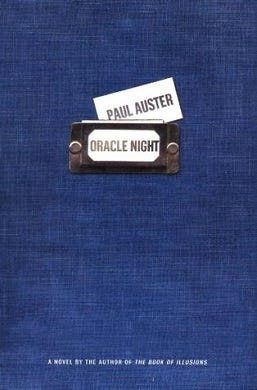Auster’s Oracle Night
Sometimes a novel defies the categories that critics like to apply. Oracle Night, a 2003 novel by Paul Auster, is one of them. It has been analyzed often in academic journals on literature (Arce Álvarez, 2018; Buday, 2019; Maniez, 2009; Moradi, 2017; Ni, 2013; Ni & Lian, 2012; Patteson, 2008; Peacock, 2006; Simonsen, 2009). It’s been employed in a psychology journal to demonstrate a model for assessing identity (Barani, 2019). It describes the creative process through a “succession of different fictional layers that overlap and reflect on each other” (Arce Álvarez, 2018, p. 241). Auster, the writer, tells the story of a fictional writer of fiction who breaks through his writer’s block by shaping a novel about an editor who is trying to assess a newly discovered novel of a fictional novelist now fictionally dead. The fictional writer draws the initial idea from a friend, a fictional novelist whose surname happens to be an anagram of “Auster.”
But the ideas in this work are not just metafiction - fiction about fiction - though his work is often described this way (Arce Álvarez, 2018; Ni, 2013), a novel of ideas in that it writes about writing novels. Auster is often called a postmodernist (Butler & Gurr, 2008), or moving between modernism and the postmodern (Espejo, 2013), though such an attribution is also contested (Peacock, 2006).
Patteson (2008, p. 116) describes its subject as “the fragility of the human sense of existence that we call, for lack of a better word, identity” (emphasis in the original). The story is thin on plot. Characters move through a landscape, mainly New York, in which they interact in a mixture of the mundane and the magical. Even the interior novel comes to a halt with its protagonist locked inside a dark, underground vault with no means of escape. The magical realism of the Paper Palace (Brooklyn and Manhattan) is not a way of solving an ontological puzzle, but rather a dead end in the main character’s search for meaning.
The puzzle arises in part through the way Auster uses the novel within the novel - a technique used differently in another novel this “stack” has reviewed - to call attention to time. In it imagination lets the protagonist-novelist of the outer layer project forward in time, play with alternative futures, then, through the magical power of the blue Portuguese notebook, lose power over the present and future, become lost in time and go missing in (mental, physical?) space even from his wife, and then become stuck in time as his character is locked in the subterranean vault. This play with space-time echoes the growing public familiarity with Einsteinian physics, another intellectual games.
Yet both the novel and the interior novel are more than puzzles or riddles. They project confusion and anguish of the narrator-protagonist of the novel and the protagonist-subject of the interior novel as the events turn their domestic lives inside out. By the end of the book, we are pretty sure but not certain that the narrator has been betrayed, though only through the evidence of his own fictionalization of his life, corroborated by the story of the life of his mentor, told ten years after the events by a biographer, who is also a fiction of the author’s invention. We are never sure what is real, except perhaps the pain of not knowing, for sure, where we stand. This cerebral, “clever” metafiction (Peacock, 2006; Simonsen, 2009) is also visceral, felt by the reader, the author, the narrator-writer and the interior novel’s protagonist.
This novel is an exercise in character analysis and development as the protagonist-novelist recovers his strength after a pre-book accident, breaks through his writer’s block, discovers through his imagined future the secrets of his wife’s “past” a decade before his finds its confirmation in the biography of his wife’s friend-lover-novelist, maybe. This is a character being re-built, then deconstructed, then reassembled in a state even more worn and tired than he started out.
I’ve read this book three times, and I’m still thinking about it, feeling it. I’m reading Auster’s latest, Baumgartner, now. From what I’ve read so far, and read about it, it’s another deeply personal, deeply intellectual, deeply penetrating use of the form.
Arce Álvarez, M. L. (2018). Paul Auster's Oracle Night: The writing of a literary space. European Journal of American Culture, 37(3), 241-264. doi:10.1386/ejac.37.3.241_1
Barani, F. (2019). Dynamics of self-dialogue in the aftermath of trauma: A “fictional dissociation”. Theory & Psychology, 29(3), 377-395. doi:10.1177/0959354319842949
Buday, M. (2019). On Writer’s Block: The Reflection of Lacanian Post-Structuralist Psychoanalysis in Paul Auster’s Oracle Night. Prague Journal of English Studies, 8(1), 139-160. doi:10.2478/pjes-2019-0008
Butler, M., & Gurr, J. M. (2008). The Poetics and Politics of Metafiction: Reading Paul Auster's Travels in the Scriptorium. English Studies, 89(2), 195-209. doi:10.1080/00138380801912883
Espejo, R. (2013). Coping with the Postmodern: Paul Auster's New York Trilogy. Journal of American Studies, 48(1), 147-171. doi:10.1017/S0021875813000698
Maniez, C. (2009). Suspendu entre passé et avenir : Oracle Night de Paul Auster. [Suspended between Past and Present: Paul Auster's Oracle Night]. Revue française d’études américaines, 121(3), 61-71. doi:10.3917/rfea.121.0061
Moradi, M. (2017). Paul Auster's ORACLE NIGHT as an Examination of the Hypersimulation. The Explicator, 75(3), 173-176. doi:10.1080/00144940.2017.1346572
Ni, H. (2013). Embedded Structure of Oracle Night as a Metafiction. Theory & Practice in Language Studies, 3(7), 1281.
Ni, H., & Lian, D. (2012). Study of the Fragmented Structure in Oracle Night as a Metafiction. Theory & Practice in Language Studies, 2(3), 540-546. doi:10.4304/tpls.2.3.540-546
Patteson, R. F. (2008). The Teller's Tale: Text and Paratext in Paul Auster's Oracle Night. Critique: Studies in Contemporary Fiction, 49(2), 115-130. doi:10.3200/CRIT.49.2.115-130
Peacock, J. (2006). Signs of Grace: Paul Auster's Oracle Night. English: Journal of the English Association, 55(211), 65-78. doi:10.1093/english/55.211.65
Simonsen, R. R. (2009). Even or(r) Odd: The Game of Narration in Paul Auster's Oracle Night. American Studies in Scandinavia, 41(1), 83-107.



